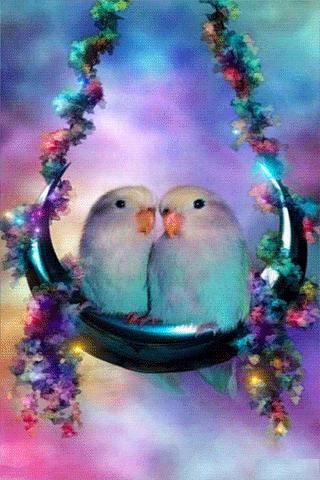| Source:- Google.com.pk |
Some species are kept as pets, and several color mutations were selectively bred in aviculture. Their average lifespan is 10 to 15 years.Lovebirds are 13 to 17 centimeters in length and 40 to 60 grams in weight. They are among the smallest parrots, characterized by a stocky build, a short blunt tail, and a relatively large, sharp beak. Wildtype lovebirds are mostly green with a variety of colors on their upper body, depending on the species. The Fischer's lovebird, black-cheeked lovebird, and the masked lovebird have a prominent white ring around their eyes. Many color mutant varieties have been produced by selective breeding of the species that are popular in aviculture.Phylogeny of the genus Agapornis based on molecular evidence. The species with the red line is currently unplaced in the phylogeny, but does belong to this genus.The lovebird genus comprises nine species of which five are monotypic and four are divided into subspecies. Eight of them are native in the mainland of Africa and the Madagascar lovebird is native to Madagascar. In the wild the different species are separated geographically.Traditionally, lovebirds are divided in 3 groups:. the sexually dimorphic species: Madagascar, Abyssinian, and red-headed lovebird. the intermediate species: peach-faced lovebird. the white-eye-ringed species: masked, Fischer's, Lilian's, and black-cheeked lovebirds
However, this division is not fully supported by phylogenetic studies, as the species of the dimorphic group are not grouped together in a single clade.Species and subspecies:Rosy-faced lovebird, Depending on the species of lovebird, the female will carry nesting material into the nest in various ways. The peach-faced lovebird tucks nesting material in the feathers of its rump, while the masked lovebird carries nesting material back in its beak. Once the lovebirds start constructing their nest, mating will follow. During this time, the lovebirds will mate repeatedly. Eggs follow 3–5 days later. The female will spend hours inside her nesting box before eggs are laid. Once the first egg is laid, a new egg will follow every other day until the clutch is complete, typically at four to six eggs. Even without a nest or a male, lovebirds sometimes produce eggs.Hybrids (Fischer's lovebird x Masked lovebird) in Nairobi, Kenya.Feral populations of Fischer's lovebirds and masked lovebirds live in cities of East Africa. Also present there are interspecific hybrids between these two species. The hybrid has reddish-brown on head and has orange on upper chest, but otherwise resemble the Masked lovebird.Feral lovebirds are also present in Phoenix, Arizona, USA and several species are found as feral populations in San Diego, California, USA.Masked lovebirds calling
MENU0:00 Recording of the blue masked lovebird variety. Problems playing this file? See media help.
With their inclination to bond, they can form long-term relationships with people in tandem with their intra-species companions. Aggression is easily aroused in lovebirds, however, and biting may occur unless a bond is established with gentle handling. Provided with adequate space, a stimulating environment, and appropriate nutrition, a lovebird can become a cherished companion parrot. They love to snuggle and often preen their favorite people. It is preferable to obtain birds bred in captivity, rather than birds caught from the wild. Wild birds may be harboring a disease, such as avian polyomavirus.Captured wild lovebirds also may mourn the loss of association with a mate or a flock. Their age is likely to be unknown, and they may have an unsuitable personality for domestication. Currently, lovebirds are no longer imported from the wild. Lovebirds are not necessarily best kept in pairs, as their name suggests, although relationships with humans are then less likely to be as intense when paired. Birds kept individually or brought up hand-fed, make very good pets. However, single birds require frequent attention to stay happy, and if the owner has limited time to spend daily with a single lovebird, it is preferable to grant the lovebird a companion of the same species, or a companion of another parrot species known to get along well with lovebirds. It is important to use caging that is suitable for smaller birds as wider-speed bars can cause damage to these small hook bills. Lovebirds can become very interactive with humans, and when comfortable, will willingly perch on a finger or shoulders.Some lovebirds talk, but many will not: there is a chance they may learn to mimic human sounds if taught to do so at a young age. Lovebirds are noisy, with calls ranging from cheerily pleasant to highly irritating; in the wild, parrots must call to each other over long distances to keep flocks together, and it is through such signals that most of their communication is made. It is best to spend frequent, short periods of time with a lovebird, rather than having just one or two interactions every day.Sexual Characteristics and Behavior Determining lovebird sex is difficult. At maturity of one year, it may show signs of whether it is male or female, such as ripping up paper and stuffing it into its feathers (female behavior) or regurgitating for its owners (male behavior: the male feeds the nesting female). This behavior is not a reliable indicator. The only sure method is DNA testing, however, some experts can sex them by feeling beneath the body. A yellow-collared lovebird perching by the entrance to a nest box in a large aviary at Honolulu Zoo, Hawaii, USA
lovebirds require an appropriately sized cage or aviary. Minimum recommended space per bird is 1m×1m×1m. Lovebird's beaks are made of keratin, which grows continuously. Chewing and destroying wood toys and perches helps to keep beaks trim. Cuttlebones help provide beak-trimming and a source of calcium and other necessary minerals. Natural perches and special rough surfaced perches of varying diameters placed at different levels in the cage will allow greater climbing mobility and gives them a choice to select the most comfortable spot to roost. They also require plenty of toys, such as willow branches, swings, tunnels, boxes and safe things to chew on and play with.Lack of toys, keeping the birdcage covered too many hours, and lack of companionship or social stimulation may lead to boredom, stress and psychological or behavioral problems (nervousness, aggression, feather-plucking, screaming, depression, immuno-suppression). Lovebirds are extremely social birds and will enjoy several hours of interaction a day. Without this interaction, daily exercise, a roomy cage/aviary, and many toys to play with, they may resort to feather-plucking, or screaming, and both behaviors can be difficult to cure. It is suggested that if the owner leaves the house that they leave a radio or TV set playing, to provide sound. Lovebirds are intelligent, and if a relationship is to form they need a human who will dedicate lots of time with them. Lovebirds enjoy baths and like to sun themselves daily.As with pet parrots in general, the tips of lovebirds' toenails should wear down adequately by the parrot climbing over rough surfaced perches. If the parrot has an inactive lifestyle, however, occasionally the toe nails grow long and may need to be trimmed. Only the very tips of the toe nails are trimmed. If too much of a toe nail is trimmed away, it will be painful and bleed from the blood vessels in the centre of the nail. This bleeding should be stopped as soon as possible with the use of styptic gel or powder. Sharp pointed toe nails that scratch the owner can be blunted by simply filing the point. These procedures are usually done with the help of an assistant carefully holding the parrot wrapped in a towel.
Love Birds Pictures Lolove Pictures For Her For Him To Draw Tumblr For MySpace Animated For Facebook Download
Love Birds Pictures Lolove Pictures For Her For Him To Draw Tumblr For MySpace Animated For Facebook Download Love Birds Pictures Lolove Pictures For Her For Him To Draw Tumblr For MySpace Animated For Facebook Download Love Birds Pictures Lolove Pictures For Her For Him To Draw Tumblr For MySpace Animated For Facebook Download Love Birds Pictures Lolove Pictures For Her For Him To Draw Tumblr For MySpace Animated For Facebook Download Love Birds Pictures Lolove Pictures For Her For Him To Draw Tumblr For MySpace Animated For Facebook Download Love Birds Pictures Lolove Pictures For Her For Him To Draw Tumblr For MySpace Animated For Facebook Download Love Birds Pictures Lolove Pictures For Her For Him To Draw Tumblr For MySpace Animated For Facebook Download Love Birds Pictures Lolove Pictures For Her For Him To Draw Tumblr For MySpace Animated For Facebook Download Love Birds Pictures Lolove Pictures For Her For Him To Draw Tumblr For MySpace Animated For Facebook Download Love Birds Pictures Lolove Pictures For Her For Him To Draw Tumblr For MySpace Animated For Facebook Download
Love Birds Pictures Lolove Pictures For Her For Him To Draw Tumblr For MySpace Animated For Facebook Download Love Birds Pictures Lolove Pictures For Her For Him To Draw Tumblr For MySpace Animated For Facebook Download Love Birds Pictures Lolove Pictures For Her For Him To Draw Tumblr For MySpace Animated For Facebook Download Love Birds Pictures Lolove Pictures For Her For Him To Draw Tumblr For MySpace Animated For Facebook Download Love Birds Pictures Lolove Pictures For Her For Him To Draw Tumblr For MySpace Animated For Facebook Download Love Birds Pictures Lolove Pictures For Her For Him To Draw Tumblr For MySpace Animated For Facebook Download Love Birds Pictures Lolove Pictures For Her For Him To Draw Tumblr For MySpace Animated For Facebook Download Love Birds Pictures Lolove Pictures For Her For Him To Draw Tumblr For MySpace Animated For Facebook Download Love Birds Pictures Lolove Pictures For Her For Him To Draw Tumblr For MySpace Animated For Facebook Download Love Birds Pictures Lolove Pictures For Her For Him To Draw Tumblr For MySpace Animated For Facebook Download










No comments:
Post a Comment